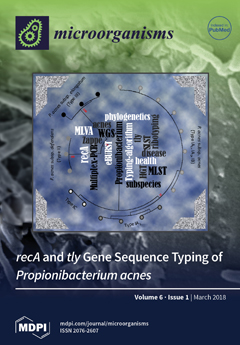Open AccessArticle
Therapeutic Management of Pseudomonas aeruginosa Bloodstream Infection Non-Susceptible to Carbapenems but Susceptible to “Old” Cephalosporins and/or to Penicillins
by
Ronit Zaidenstein 1,2,†, Asaf Miller 3,†, Ruthy Tal-Jasper 1, Hadas Ofer-Friedman 1, Menachem Sklarz 4, David E. Katz 5, Tsillia Lazarovitch 6, Paul R. Lephart 7, Bethlehem Mengesha 1, Oran Tzuman 1, Mor Dadon 1, Chen Daniel 1, Jacob Moran-Gilad 8,9,10 and Dror Marchaim 1,2,*
1
Unit of Infectious Diseases, Assaf Harofeh Medical Center, Zerifin 70300, Israel
2
Sackler School of Medicine, Tel-Aviv University, Tel-Aviv 6997801, Israel
3
Intensive-Care Unit, Assaf Harofeh Medical Center, Zerifin 70300, Israel
4
Bioinformatics Unit, National Institute for Biotechnology in the Negev, Beer-Sheva 84105, Israel
5
Department of Internal Medicine, Shaare Zedek Medical Center, Hebrew-University, Hadassah Medical School, Jerusalem 91031, Israel
6
Clinical Microbiology Laboratory, Assaf Harofeh Medical Center, Zerifin 70300, Israel
7
Department of University Laboratories, Detroit Medical Center, Detroit, MI 48201, USA
8
Department of Health Systems Management, Faculty of Health Sciences, Ben-Gurion University of the Negev, Beer-Sheva 84105, Israel
9
Public Health Services, Ministry of Health, Jerusalem 91010, Israel
10
ESCMID Study Group for Genomic and Molecular Diagnostics (ESGMD), 214 4010 Basel, Switzerland
†
Ronit Zaidenstein and Asaf Miller had contributed evenly to this publication.
add
Show full affiliation list
remove
Hide full affiliation list
Cited by 9 | Viewed by 4163
Abstract
It is unknown as to whether other beta-lactams can be used for bloodstream infections (BSI) resulting from
Pseudomonas aeruginosa (PA) which are non-susceptible to one or more carbapenem. We conducted a retrospective cohort study at the Assaf Harofeh Medical Center (AHMC) from January
[...] Read more.
It is unknown as to whether other beta-lactams can be used for bloodstream infections (BSI) resulting from
Pseudomonas aeruginosa (PA) which are non-susceptible to one or more carbapenem. We conducted a retrospective cohort study at the Assaf Harofeh Medical Center (AHMC) from January 2010 to August 2014. Adult patients with PA-BSI non-susceptible to a group 2 carbapenem but susceptible to ceftazidime or piperacillin (with or without tazobactam), were enrolled. We compared the outcomes of patients who received an appropriate beta-lactam antibiotic (“cases”) to those who received an appropriate non-beta-lactam antibiotic (“controls”). Whole genome sequencing was performed for one of the isolates. Twenty-six patients with PA-BSI met inclusion criteria: 18 received a beta-lactam and 8 a non-beta-lactam (three a fluoroquinolone, two colistin, one a fluoroquinolone and an aminoglycoside, one a fluoroquinolone and colistin, and one colistin and an aminoglycoside). All clinical outcomes were similar between the groups. There were large variations in the phenotypic susceptibilities of the strains. A detailed molecular investigation of one isolate revealed a strain that belonged to MLST-137, with the presence of multiple efflux pumps, OXA-50, and a chromosomally mediated Pseudomonas-derived cephalosporinase (PDC). The oprD gene was intact. Non-carbapenem-β-lactams may still be effective alternatives for short duration therapy (up to 14 days) for BSI caused by a carbapenem non-susceptible (but susceptible to ceftazidime, piperacillin, and/or piperacillin-tazobactam) PA strain. This observation requires further confirmatory analyses. Future molecular investigations should be performed, in order to further analyze additional potential mechanisms for this prevalent phenotype.
Full article






